2012 VOLKSWAGEN GOLF PLUS battery
[x] Cancel search: batteryPage 258 of 541
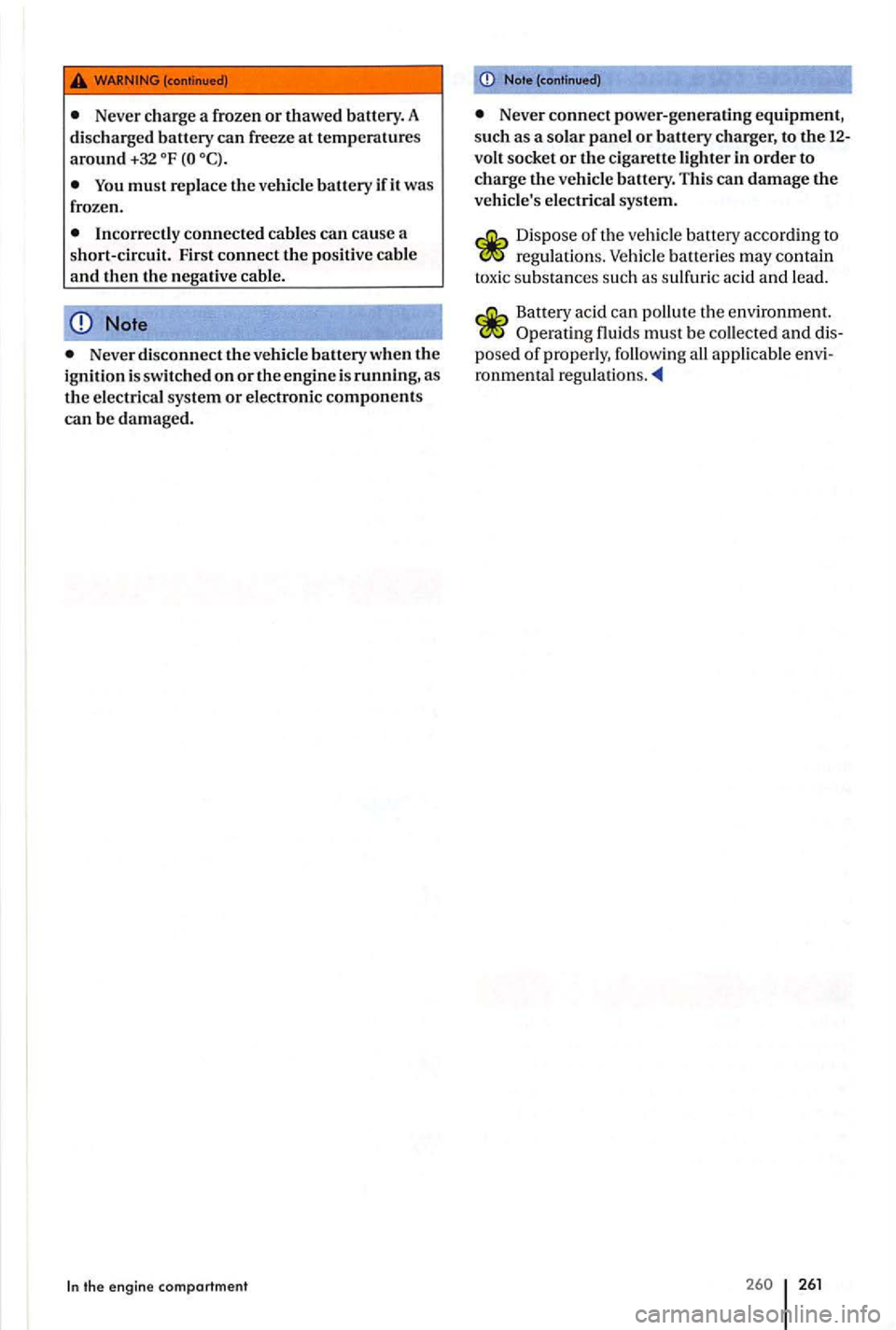
Never charge a frozen or thawed battery. A
disch arged battery can freeze at temperatures around +32
Note
Never disconnect t11evehicle battery when the ignition is s witched on or the engine is running, as the electrica l system or electronic components can be damaged.
Note
Never connect power-generating equipment,
such as a solar panel or battery charger, to the 12-volt s ocket or the c igar ette light er in order to
charge the vehicle battery. This can damage the vehicle's electrical system.
Battery acid can pollute th e e nvironment. Operating mu st be collecte d and posed of properly, following all applicable
261
Page 315 of 541
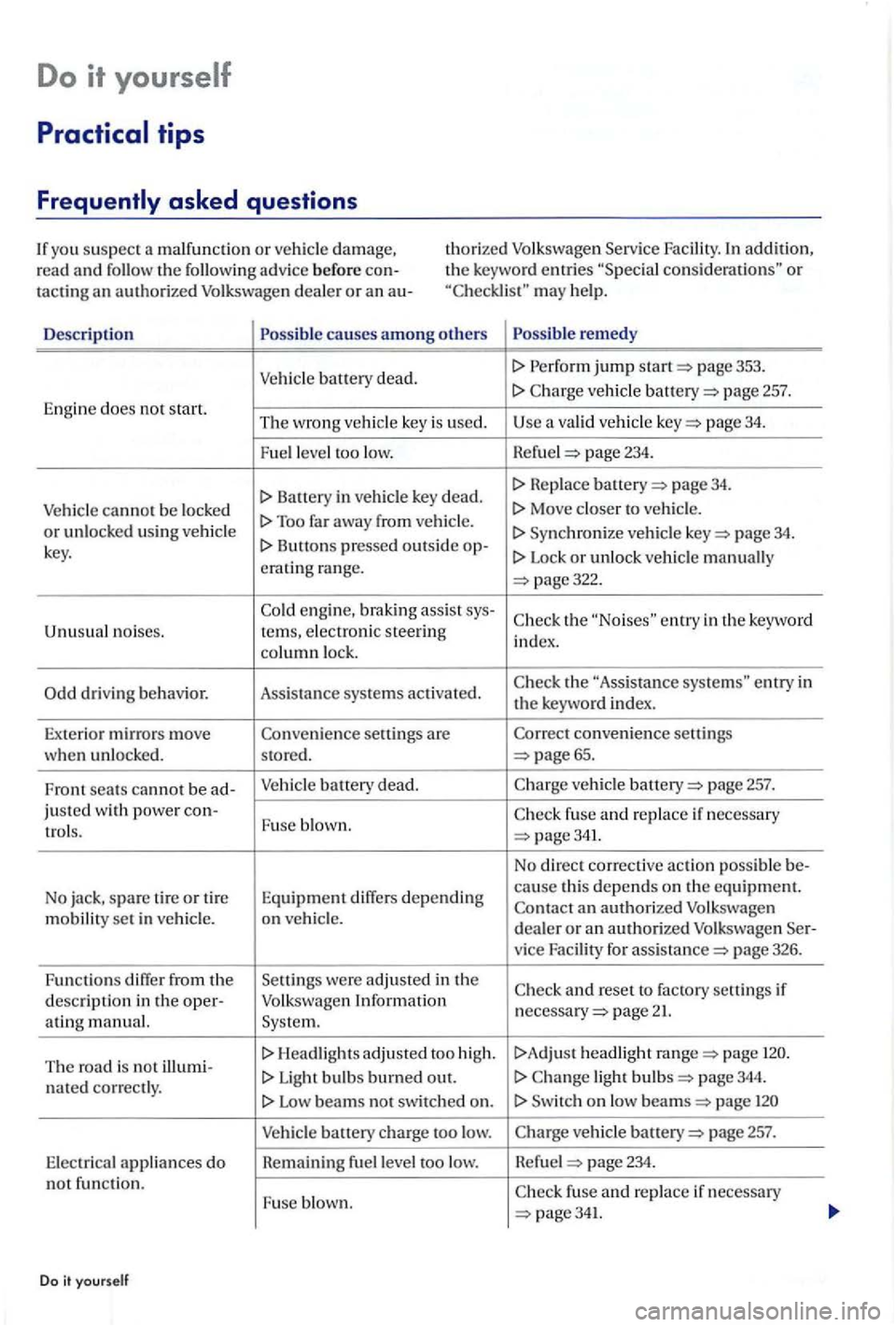
Do it yourself
con sid era tions" or may help.
De
scription causes amon g oth ers remed y
Vehicl e ba tt ery dead. jump page 353.
page 257. Engine does no t start. The wrong ve hicle key is used. a valid ve hicl e page 34.
Fuel leve l too low. Hefue l 234.
Batt ery in ve hicl e key dead. page 34.
Vehicle cannot be locke d Too far away from vehicle . Sy nchroni ze veh icle page 34. key. Lock or unlo ck vehicl e manually
crat ing range. page322.
en gine, braking assis t sys-th e entry in the ke yword noises. te rns, e lectro nic steering index.
co lumn lock.
the "Assis tance e ntry in the keywo rd in dex .
Exterior mirro rs move convenience settings
w he n unl ocke d . stored. 65.
F ront seats can not be ad -Vehicle battery dead. veh icle page 257.
jus ted with power con-Fuse b lown.
a n authoriz e d Volkswage n
m obilit y se t in vehicle. on ve h icl e. dealer or an authori zed Volk swagen Ser-
v ice Facility for page 326.
Func tions diff
er from th e Settin gs were adju ste d in th e and reset to fac tory settings if
descript ion in the oper-Volkswagen Information page 2 ating manual. Syste m.
T he road
is not illumi-H ea dlights a djusted too hig h . !>A dju st headlig ht page
n a ted correctly. Light b ulb s burned out. ligh t page 344.
Low beams no t swi tched on . Switch on low page
Vehicle battery ch a rge too low. page 257.
E lect rica l a p plian ces do Remaining fuel le vel too low. Refu el page 234. not functi on.
page341.
Do it yourself
Page 318 of 541

Checklist (continued )
6. passengers exit and go to a safe locatio n
vehicl e keys with you when lea vin g yo ur ve hicl e.
8. up ale rt other m otoris ts and cycl is ts .
9. Let th e eng in e cool down and ge t ex pert ass is tance if necessary .
the emerge ncy flashers are on. use the turn sig nal lever to indicat e when the ve hicl e is bein g towe d. T his
t empo rarily interr upts th e wa rnin g fla sh ers.
Traffi c suddenl y slows down or s top s in front of you to wa rn those approaching fro m b ehind .
the of an em erge ncy.
the ve hicle brea ks dow n.
b ein g tow-s tarted or bei ng towed.
A lways obey traffic
that govern the use o f
e m erge ncy flash ers where you are driving.
th e em ergency flash e rs are not working . a fe rent method -as pe rmitt ed by law-must b e
used to alert othe r m otoris ts an d cycl is ts to the breakdown.
Di sregarding the sa fety-related ch ecklist may lead to accidents and serio us injuries.
A lway s review and th e c hecklist. safe ty prac tice s and use common sense.
Pract ical tips
Th e vehicl e ex hau st syst em and the ca tal ytic
co nverter or diesel pa rti cu late
Never park where parts of the hot ex haust sys te m or catalyti c converter could ignite mable materials, such as dry grass, brush ,
l eaves,
T he ve hicl e battery be drained if th e em ergency flas he rs are o n for a long tim e
To alert the traffi c behind you, th e brake light s o n some ve hicle s sta rt to fla sh if you
brake hard when traveling at a speed greate r about mph km /h ).
a t speeds around 6 mph
ating d eact iva tes th e e merge ncy flash ers.
To alert the tr affic behin d you, the ge ncy flashers on so me ve hicl es come on if you br ake hard w hen traveling at a speed greater than mph krn/h ). accele ratin g
o r continuing to drive at a speed above about25 mph km /h ), th e e merge ncy flashers
Page 350 of 541
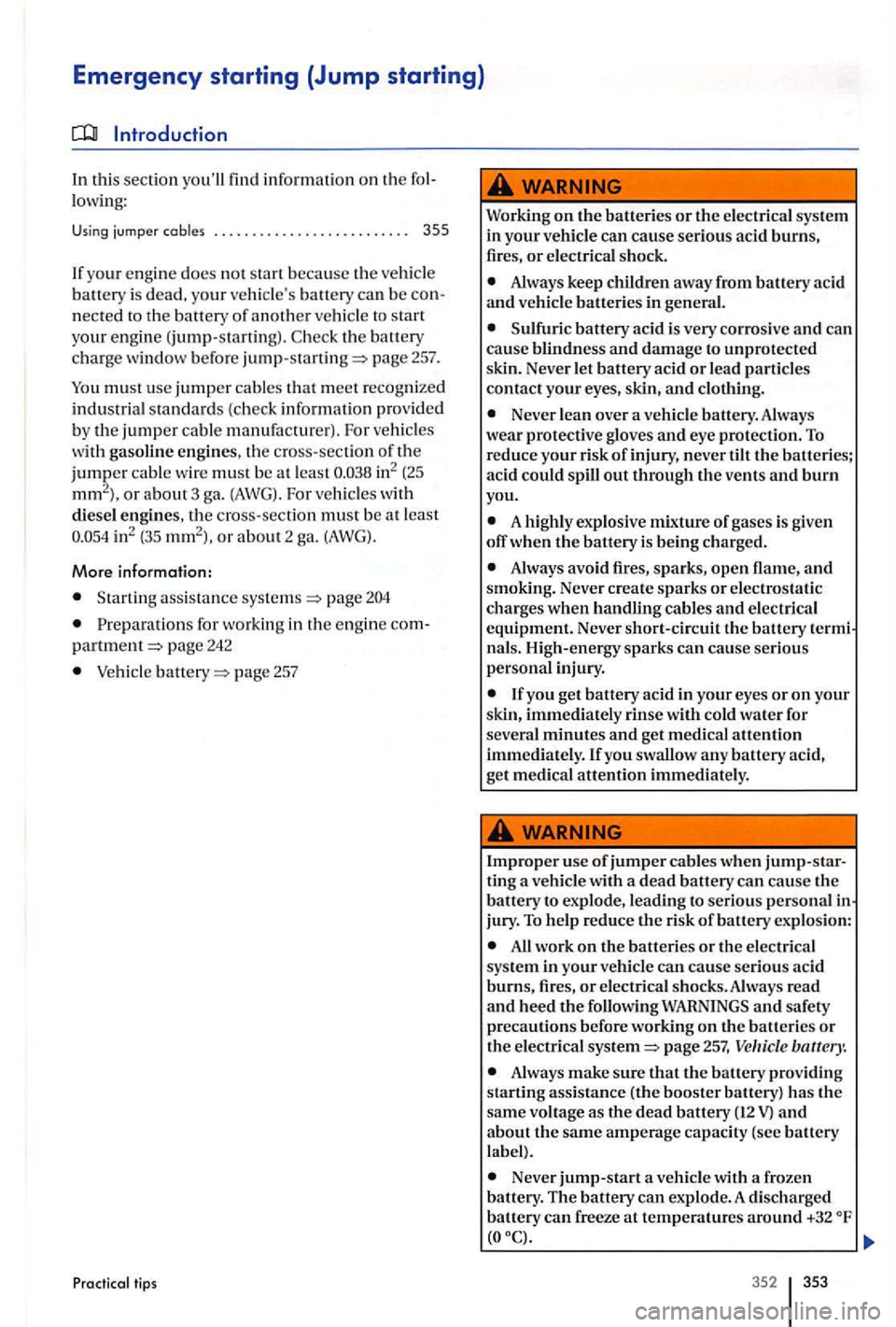
Emergency starting (Jump starting)
In this section information on the lowing :
Using jum per cables . . . . . . . .
your engin e do es not start because the ve hicl e battery is your ve hicle's ba tt ery nected to th e battery of an oth er ve hicl e to s tart
your eng ine (jump- starting). page 257.
You m ust use jumpe r cables th at m eet rec og ni ze d
indu strial standard s (ch eck inform ation provid ed
b y th e
jumper cabl e manufa cturer). For vehicl es
with gasoline engines , the cross-sec tion of th e jumper cable wire must be at le a st in2 (2 5 or about 3 ga. Fo r v ehicl es with
diesel engines, th e cro ss-section must b e at lea st or abo ut 2 ga.
More information:
Starting assis tance sy s tem s page
Preparations for working in th e e ngin e page 242
Vehicl e page 257
Practical tips
on the batteries or the electrica l system
in your vehicle can cause serious acid burns, fires, or elec trical shock.
Always keep children away from battery acid and vehicle batteries in general.
Sulfuri c battery acid is very corrosive and can
cause blindn ess and damage to unprotected
ski n. Never let battery acid or lead particles
contact your eyes, skin, and clothing.
Never lean over a veh icle battery. Always
wear protective glo ves and eye protection. To reduce your risk of injury, never tilt the batteries;
acid could out through the vents and burn you.
A highly explosive mixture of gases is given
off when the battery is being charged.
Always avoid fires, sparks, open and smoking. Never create sparks or electrostatic
charges when handlin g cable s and electrica l equipment. Never short-circui t the battery nals. High-energy sparks can cause serious
personal injury.
If yo u ge t batt ery acid in your eyes or on your ski n, immediately rinse with cold wate r for
severa l minutes and get attenti on
immediately. If yo u swallow any battery acid,
get medical attention immediately.
Improper use of jumper cables whe n jump-startin g a ve hicle with a dea d battery can cau se th e
battery to exp lode, leading to serio us personal in
jury.
To h elp reduce the risk of battery explo sion :
All work on the batterie s or the ele ctrical
system in your vehicle can cause serious acid
burns, fires, or electrica l shocks. Always read
and heed the following
page 257,
Always make sure that the battery providing
starting assistance (the booster battery) has the same vo lta ge as the dead battery (12 V) and
a b o ut th e same amperage capaci ty (see battery label).
Never jump-start a ve hicl e wit h a frozen battery . The battery can exp lode. A discharged
battery can freeze at temperatures around +32
352 353
Page 351 of 541
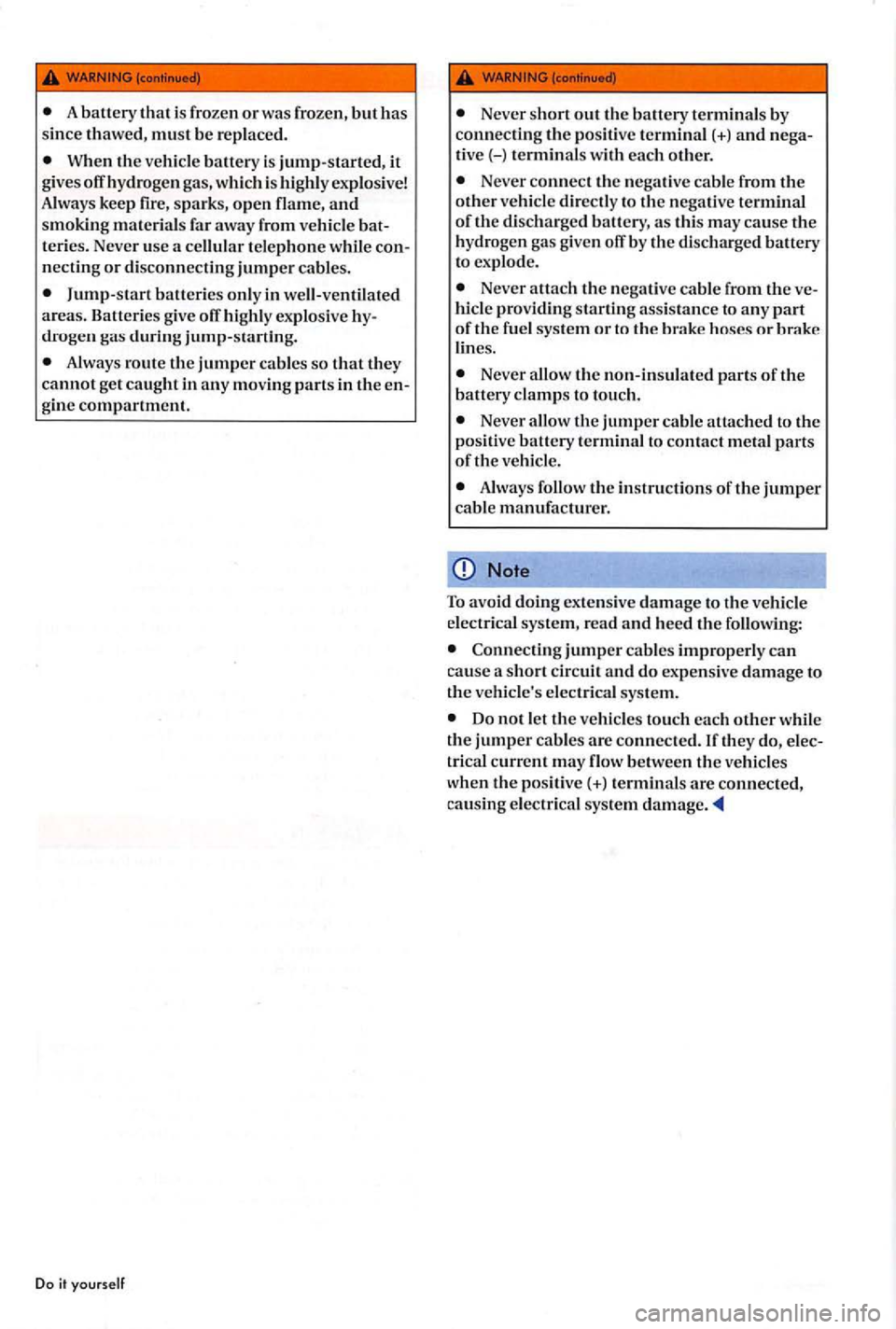
When the vehicle battery is jump-started, it give s off hydroge n gas , which is highl y exp losive!
A lw ays keep fire, sparks, ope n flame , and smoking materi als fa r away from vehicle
necting or disco nnecting jumper cable s.
Jump-s ta rt batterie s only in well-ventil ated
areas. Batteries give off highly explosive
Always route the jumper cables so that they cannot get caught in any moving parts in the
..
Never short out the battery terminals by
connecting the positi ve termina l(+) and
Never connect the negative c abl e from the other vehicle directly to the negativ e terminal of the di scharged b atte ry, as thi s may cause the
hyd rog en gas given off by the di sc harg ed battery
to explod e.
Never att ac h the negati ve cable from the hicl e providing starting assistance to any
Never allow the non-insulat ed parts of the battery clamps to tou ch.
Never allow the jumper cable attached to the
po sitive battery te rminal to contact metal parts of the vehicle.
Note
To avoid doing exte nsive damage to the vehicle
elect rica l system, read and heed t11e following:
Connecting jumper cables imprope rl y can ca use a short cir cuit and do expensive damage to the ve hicl e's electric al sys te m.
Do not le t the ve hicles touch eac h other whil e
the jumper cab les are conncc te d.Iftl1 ey do,
Page 352 of 541
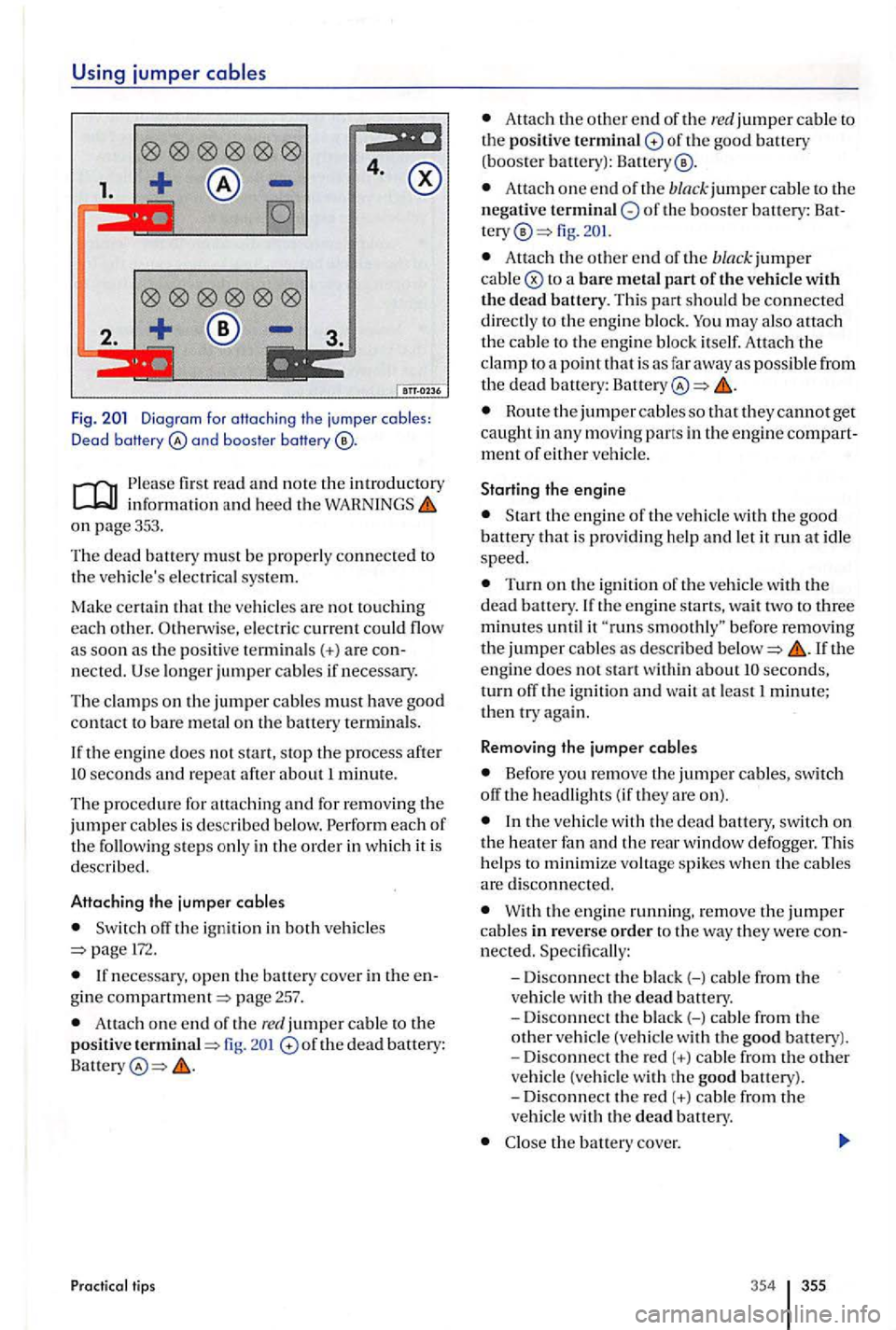
Using jumper
4.
1.
2.
Fig. and boos te r baHery
informat ion and heed the on page 353.
Th e
dead battery must be properly connected to
th e ve hicle's electri cal sys tem.
Ma
ke certain
pos iti ve termin als(+) a re
the engine does not start, stop the process after seconds and repeat after about 1 minute.
Th e procedu re for attach ing
and for removing the jumper cables is desc ribed below.
off the ign ition in both vehicle s 172.
gine compartment=> page 257.
Attach one end o f th e red jumper cable to the positive termina l=> fig. of th e dead battery:
Pr actical tips
Atta ch the o ther end of the re d jumper cable to th e positive terminal of the good battery (booster battery):
Attach one e nd of the black jumper cable to th e
n egative of the booste r battery : fig.
Attac h the oth er e nd of the bla ck jumper cable
may also attach the cable to the e ng in e bl oc k itself. Attach the clamp to a poi nt that is as far away as possible from the dead battery: Battery
Route the jumper cable s so that they cannot get caught in a ny moving pans in th e engine ment of either vehicle.
Starting the engine
is prov idi ng h elp and let it run at i dle speed.
Turn on the ign ition of the ve hicle with the dead battery.
seconds, turn off th e ignition and wa it at least 1 minute; then try again.
Remo ving the jumper cables
Before yo u remove the jumper cables , switch
off the headligh ts ( if they are on).
the ve hicl e w ith the dead battery, switch on the heater fan and the rear window defogger. This
h elp s to minimize voltag e spikes when the cables are disconne cted.
With the engin e running. remove the jumper cable s in reverse order to the way they we re
the bauery cove r.
354 355
Page 353 of 541

Improper usc of jumper cables when starling a ve hicl e wit h a dead battery can cause the battery to exp lode, leading to serious sonal injury. To help red uce the risk of battery
explo sion:
All work on the batteri es or the elec trical
sys tem in your veh icle can cause serious acid burns, fire s, or e lec trica l shocks. Always read and heed the followin g WARNINGS and safety
precaution s before working on the batteries or the electrical page 257,
Always wear proper eye protection. Never
lean over the vehicle batteries.
Attach the jumper cables in the correct order:
first the positive cable, then the negative cable.
Never connect the negative cable from the ve hicl e providing starting assistance to parts of th e fuel system or to the brake hoses or brak e
line s.
Never allow no n-i nsu lated parts of the battery clamp s to touch. Never allow the jumper cable attache d to the positive battery terminal to
contact metal parts of the ve hicle.
Do it yourself
hicl e battery. If you cannot sec the color ofthe window clearly, never usc a cigare tte
light er, or other open Use
Avoid electrosta tic dischar ge in the vicinity of the ve hicl e battery . Sparks may cause the
Neve r jump start
A lways follow the instru ction s of the jumper cable manufacturer.
Always make sure that the battery providing
star ting assistance has th e same vo lta ge as the dead battery (12 V) and about the same capacity
(sec battery lab el).
Batterie s give off explos ive hydrogen gas. ways keep fire, sparks , open and smoking
materials away from batteri es.
Never connect the negat ive cab le from the other vehicle directly to the negative terminal of the dead battery. The hydrogen gas from the battery is exp losive.
Neve r short out the battery te rminals by co nn ecting the positi ve(+) and negati ve(-)
terminal s with each other.
Page 354 of 541
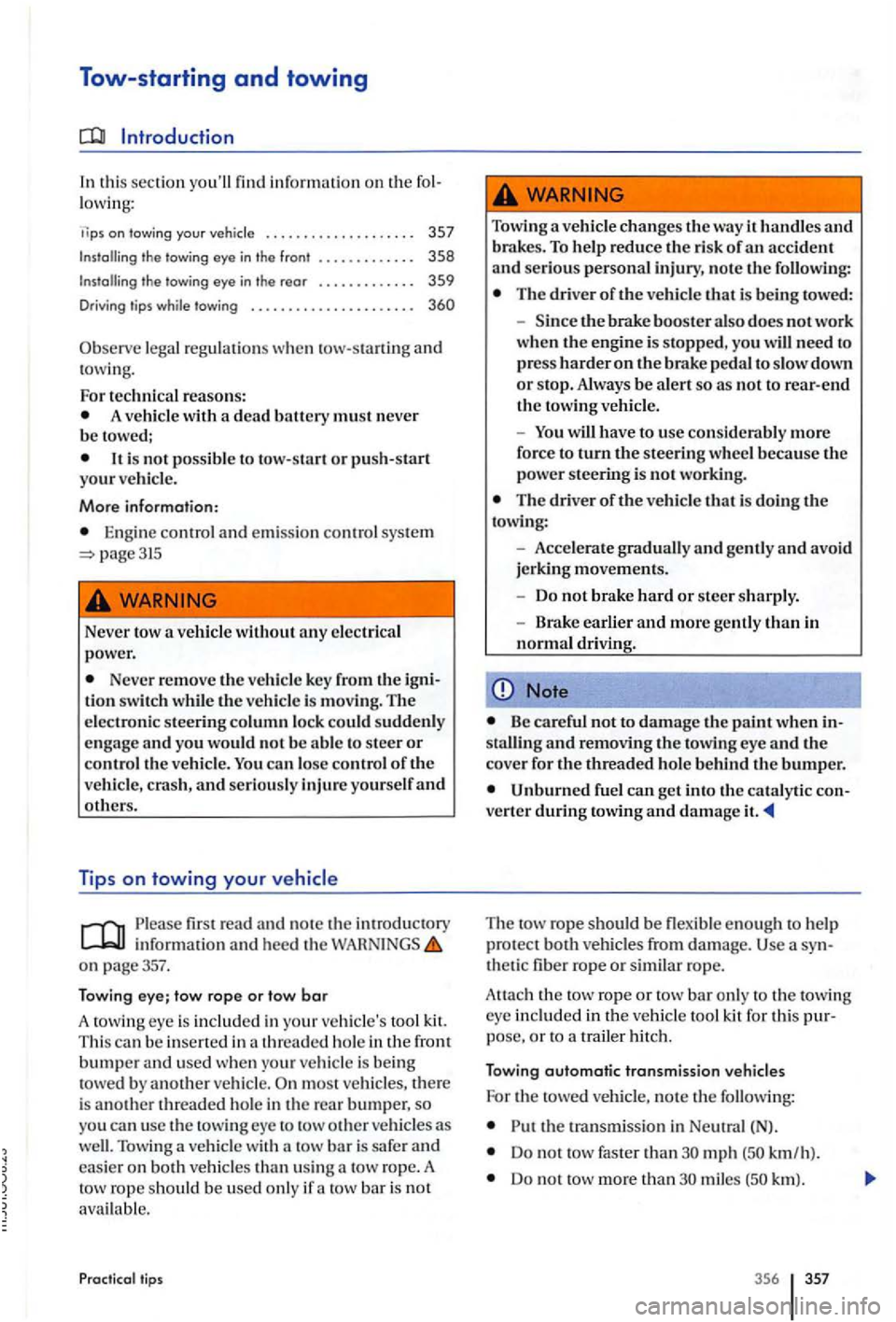
Tow-starting and towing
Introduction
In thi s sec tion you'll find informati on on the low ing:
ti ps on towin g your vehicle . . . . . . . . . . . . . . . . . . . 357
Installing the towing eye in the fron t . . . . . . . . . . . . . 358
In stalling the towing eye in the rear . . . . . . . . . . . . . 359
Driving tips while towing . . . . . . . . . . . . . . . . . . . . . .
Ob serve lega l regulations tow -startin g and
t ow ing.
For technical rea sons: A vehicle with dead battery must never be towed;
Engin e control and emissio n control system page315
Never tow a vehicle without any electrica l
power.
Neve r remove the vehicle key from the
first r ea d and no te th e introductory inf ormation and heed the WARNINGS on page357.
Towing eye; bar
A to w ing eye is includ ed in your vehicl e's tool kit.
Thi s ca n b e inserted in a th rea ded h ole in the front bumper a nd use d whe n your ve hicl e is bei ng
t owed by an o th er ve hicle.
Towing a veh icle change s th e way it handles and brake s. To help reduce the risk of an accident and serious personal injury, note the following:
The driver of the ve hicl e that is being towed:
-
need to
press harder on the brak e pedal to slow down or stop. Always be alert so as not to rear-end the towing vehicle.
-
You will have to use conside rably more
force to turn the steerin g whee l because the power steering is not working.
The driver of the ve hicl e that is doing the towing:
- Accelerate gradually
and gently and avoid
jerking movements.
- Do
not brake hard or stee r sharply.
- Brake earlier
and more gently than in normal driving.
Note
Be careful not to damage the paint when stalling and removing the eye and the cove r for the threaded hole behind the bumper.
Unburned fuel can get into the catalytic verter during towing and damage it.
The tow rope s ho uld be nexib le e no ug h to help
protect both v ehicle s from damage . thetic fiber rope or simil ar rope.
A tta ch th e
tow rope or tow bar onl y to the towing
eye included in the vehicl e tool kit for thi s
the transmission in Ne utra l (N).
Do not tow faster than mph km /h ).
D o not tow more than miles